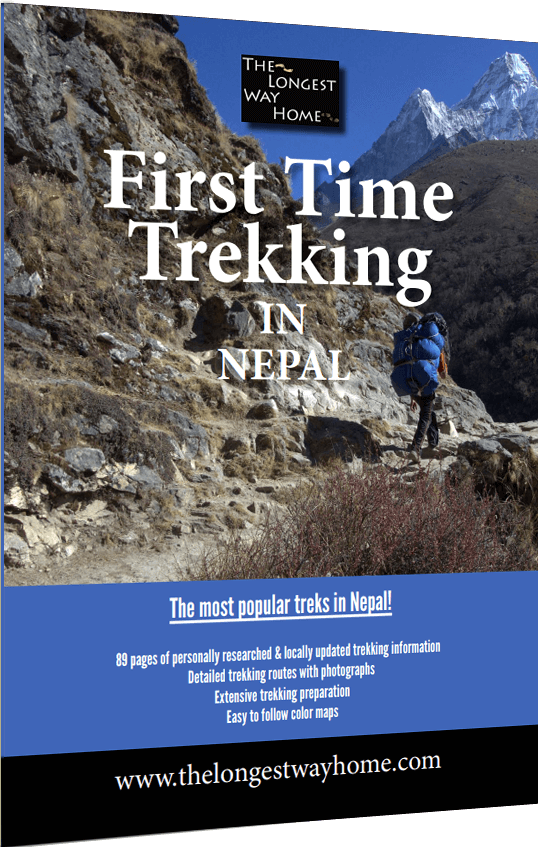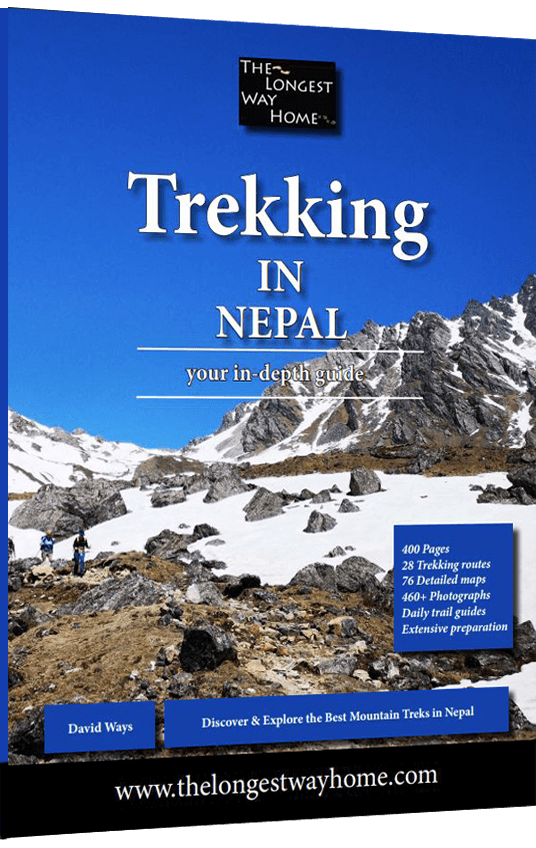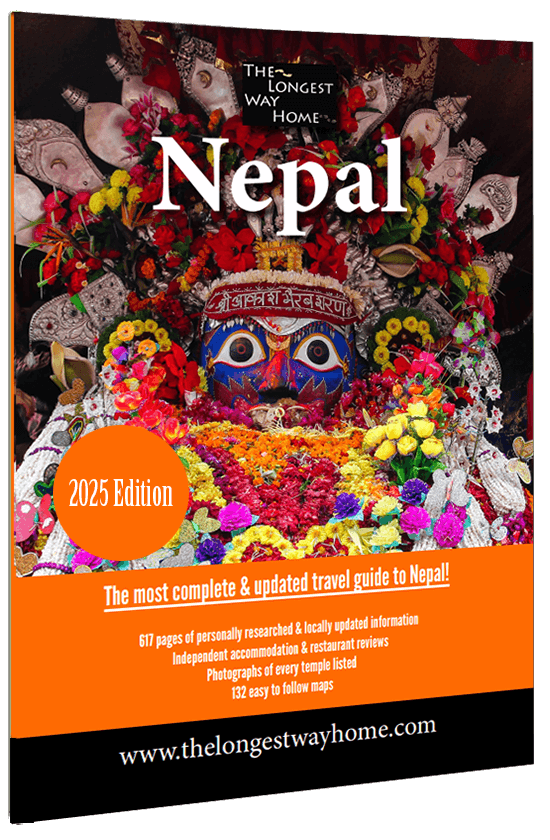Trekking in Nepal during January
January is usually the coldest month in Nepal for trekking.

Nepal has five seasons and January falls in right the middle of winter. Most people do not trek during January in Nepal for many reasons including safety.
If your trek runs from December into January then you may not be able to complete it. Snow falls and freezing temperatures can often block passes. Expect temperatures to drop well below freezing (often hitting -25) not including windchill factors.
January trekking tips
- Stick to short day hikes and not treks
- Don't go on extended treks or treks with high passes/base camps
- Dress in Layers
- Take a guide and be sure to check in at every stop
Very few people consider trekking during January in Nepal. Short hikes around Nagarkot or Dhulikhel should be possible. Dhampus near Pokhara should also be possible. Longer treks to Everest or the Annapurna Circuit are not recommended at this time of year.
What is the weather like in January for trekking in Nepal?
January in Nepal signifies the heart of winter, bringing intensely cold conditions to the mountains. Temperatures at higher altitudes can plummet to a frigid -30 degrees Celsius or even lower, making it one of the coldest months for trekking.
The biting wind chill further exacerbates the cold, creating potentially dangerous conditions. Passes and base camps are particularly vulnerable and can easily become inaccessible due to heavy snowfall and ice accumulation.
The risk of avalanches is also a significant concern, especially as fluctuating temperatures can destabilize snowpack. Trekking in January presents serious challenges and requires careful consideration and thorough preparation.
While lower elevations might experience slightly milder daytime temperatures, the overall climate remains cold, and nighttime temperatures will invariably be well below freezing.
Snowfall is common throughout the month, and trails can be icy and treacherous. Trekkers should be prepared for unpredictable weather patterns, as conditions can change rapidly and dramatically. January treks are best suited for experienced mountaineers and trekkers who are well-equipped and possess a deep understanding of winter mountain conditions.
It's absolutely vital to closely monitor weather forecasts, maintain constant communication with local guides and authorities, and be prepared to alter or even abandon your itinerary if necessary. Safety should be the paramount concern for anyone venturing into the Nepali mountains in January.
* Weather temperatures and conditions change as you go up in altitude or descend. Likewise, there are variations depending on the specific trek and microclimates within the region. Always expect passes and base camps to have more extreme conditions. The temperatures listed here are only used as rough indications. It's essential to consult detailed weather forecasts specific to your chosen trekking route and altitude before your trip, and be prepared for rapidly changing conditions.
Historical weather data for trekking in January
Since publishing my guidebooks we've been keeping an accurate record of both GPS data for trails and the weather to try and help trekkers make decisions.
The following information is correlated based on real trekking guides and trekkers who were in the following areas. The weather data is broken down into the year of the trek, weeks in the month and a note on what a guide or person experienced in terms of weather. We've used EBC, ABC and the APC for weather examples as they cover the widest range of areas.
EBC = Everest Base Camp. ABC = Annapurna Base Camp. APC = Annapurna Circuit.
* Blank years or months just means the guide or data is/was not available. It may also mean we've not had the time to update the data here (we have a lot of data on all treks). We are trying to keep this information as accurate as possible. If you are looking for specific data you may contact us, however you can best support this site by purchasing a guidebook first.
This historical climate/weather data may be useful to some but do remember that that the weather can change on an hourly basis in Nepal.
What trekking clothing is needed during January in Nepal?
Layering is absolutely vital for trekking in Nepal during January. The extreme cold necessitates a well-chosen system of clothing to stay comfortable and safe. Sturdy, insulated trekking boots are a must, designed to handle snow and ice.
Thick, thermal socks will keep your feet warm, even in sub-zero temperatures. Thermal underwear, both top and bottom, forms the essential base layer for retaining body heat.
A windproof and heavily insulated winter trekking jacket is crucial, providing protection against biting winds and snowfall. Trekking trousers and a fleece offer a good mid-layer combination. While sunny days might make trekking shirts comfortable during exertion, be prepared to add layers quickly as temperatures can plummet.
A warm sleeping bag is essential for January treks, ensuring comfortable nights in potentially very cold teahouses. While blankets are often available, a good sleeping bag provides much better insulation.
Is trekking accommodation on the trails open during January in Nepal?
Accommodation in Nepal's major cities remains open throughout the year. However, trekking accommodation in January is a different story. Many teahouses along trekking routes close down for the winter months.
As temperatures drop and snowfall increases, teahouse owners often relocate to lower, warmer valleys. Finding open teahouses can be a real challenge. While some guesthouses on main trails might remain open, there are no guarantees. It's absolutely crucial to research and confirm accommodation availability well in advance of your trek. Pre-booking is highly recommended, as relying on finding a place upon arrival can be risky.
Are trekking restaurants on the trails open during January in Nepal?
Similar to accommodation, many restaurants and teahouses along the trekking trails close for the winter in January. The same factors that lead to teahouse closures – harsh weather and fewer trekkers – also impact food service establishments.
Finding open restaurants, especially in more remote areas, can be difficult. Carrying some readily accessible snacks, and perhaps even supplementary food supplies, is a wise precaution, especially if you're trekking in less-trafficked regions.
Remember the established practice: if you stay at a teahouse, you're generally expected to eat there. It's part of the local teahouse culture. Confirm their policy on outside food and drinks to avoid any misunderstandings.
For a comprehensive understanding of teahouse etiquette and dining customs, please refer to my guidebook trekking in Nepal.
Are trekking permits available in January in Nepal?
Yes, trekking permits are available year round in Nepal including January. Permits are available in both Kathmandu and Pokhara.
Do you need travel insurance for trekking in January?
Quite frankly you'd be crazy not to have proper travel insurance when trekking in January. Do read about getting proper travel insurance for trekking in Nepal.
Find out when is the best time of year for trekking in Nepal
DDo read my full article on when is the best time of year to go trekking in Nepal for a full overview which it makes it easy to pick the best season to go trekking. Meanwhile here's a monthly breakdown.
» What's it like to trek in Nepal in January?
» What's it like to trek in Nepal in February?
» What's it like to trek in Nepal in March?
» What's it like to trek in Nepal in April?
» What's it like to trek in Nepal in May?
» What's it like to trek in Nepal in June?
» What's it like to trek in Nepal in July?
» What's it like to trek in Nepal in August?
» What's it like to trek in Nepal in September?
» What's it like to trek in Nepal in October?
» What's it like to trek in Nepal in November?
» What's it like to trek in Nepal in December?
Again, if you are trying to make plans it'll be easier to read when is the best time of year to go trekking in Nepal first, then the monthly breakdown.
More information on Trekking in Nepal
The above information should give you a brief outline and understanding about trekking in Nepal in January.
I've compiled more detailed articles on the specifics of trekking in Nepal below.
You will find them to be a great place to thoroughly research your trip to Nepal, be sure to bookmark them so you don't forget!
| You might find my following free guides helpful: | ||||
|---|---|---|---|---|
 |
My guide on trekking in Nepal |
 |
Check out my guide on equipment & gear needed for trekking in Nepal | |
 |
Check out my list of treks to do in Nepal complete with maps |  |
Check out my guide on how to travel overland into Tibet for a lot more! | |
 |
How to choose a trekking guide in Nepal |  |
My Day by day account of trekking to Everest Base Camp in the off season (winter) | |
 |
Check out my How to travel overland into Nepal guide |  |
Check out my country Guide to Nepal | |
These guidebooks are a hands on trekking guidebooks that are better than the rest. Yes, really!
The books contain day-by-day guides with accuracy using scalable maps, photographs and travel-tested up-to-date trekking information. Just like my other guidebooks these have been proven to be the best interactive, or paperback guidebooks to Nepal available anywhere today.
So what are you waiting for? Get your hands on these guidebooks and start trekking in Nepal today!
 |
 |
First Time Trekking in Nepal Guidebook
|
Trekking in Nepal Guidebook
|
 |
|
| Full Nepal Guidebook Complete country guide that also includes First Time Trekking in Nepal Discover more guidebooks to Nepal! |
|
Was this page helpful to you? If so please tell others!










